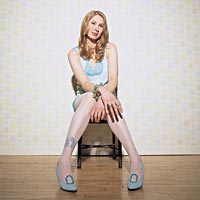|
F
ive years ago, Casey Gunschel was a struggling artist helping to rebuild the bar at the Long Room on Irving Park Road. During the project, she stumbled upon a swatch of 1940s-era wallpaper that featured circus animals drinking martinis.
“I just loved it,” she says, “and I thought, Nobody does this anymore. Wallpaper is a lost art.” Her discovery inspired PalacePapers, a company based in Gunschel’s Wicker Park loft that became an overnight success story this winter when her designs landed in a fashion forward Los Angeles boutique and then The New York Times.
When Gunschel, now 33, first floated the idea of a wallpaper company, people weren’t buying the stuff-a fact she attributes to a leftover association with bad 1980s wall vinyl: “You say wallpaper, and people think, Ick.” But in the two years it took her to create a catalog of hand-drawn contemporary designs, and then hunt down a professional silk-screener who met her standards, wall-paper suddenly became trendy again, thanks to the burgeoning shelter magazine set.
Before launching PalacePapers, Gunschel was an Art Institute dropout doing large-scale installation work and set design for Redmoon Theater and faux-finishing homes in Wilmette and other suburbs. In her spare time, she painted anthropomorphic animals on antique maps, work that earned her showings at Ann Nathan Gallery. Her paintings suggest her animal- and botanical-based wallpaper patterns, which repeat whimsical images like dinosaur skeletons, frilly carrots, or antler-locked deer until, often, together they resemble a regal damask print. Gunschel’s playful designs will likely re-surface in her matching fabric line, set to launch this summer.
Today, the L.A.–based Walnut Wallpaper and Trim processes Gunschel’s orders, except for those from Chicago-ans, which the designer handles herself through her Web site, Palacepapers.com. A tireless one-woman operation, Gunschel prefers going it alone so she can keep her attention focused on creating original designs-a tedious and highly mathematical process that involves scissors, reams of graph paper, and countless trips to Kinko’s, as well as hand-painting ink on acetate. But ask her to hang the stuff? “I don’t know how,” she says. “And I don’t want to.”
Photograph: Photograph: Katrina Wittkamp
Clothing and makeup:Sarah Staskauskas
Hair: Joanne Morrison



